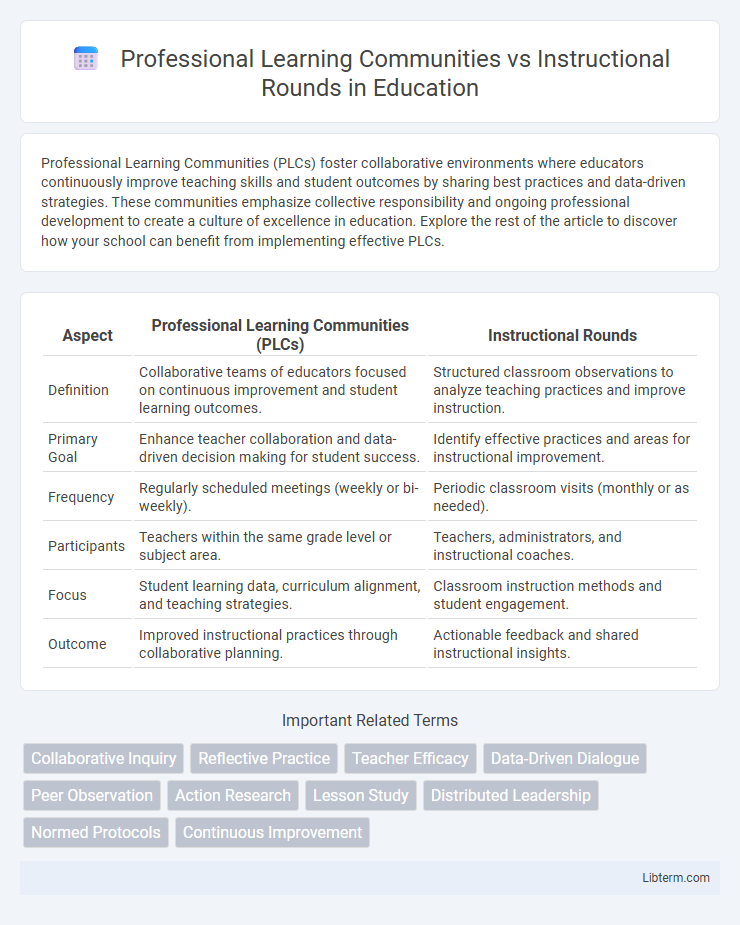Professional Learning Communities (PLCs) foster collaborative environments where educators continuously improve teaching skills and student outcomes by sharing best practices and data-driven strategies. These communities emphasize collective responsibility and ongoing professional development to create a culture of excellence in education. Explore the rest of the article to discover how your school can benefit from implementing effective PLCs.
Table of Comparison
| Aspect | Professional Learning Communities (PLCs) | Instructional Rounds |
|---|---|---|
| Definition | Collaborative teams of educators focused on continuous improvement and student learning outcomes. | Structured classroom observations to analyze teaching practices and improve instruction. |
| Primary Goal | Enhance teacher collaboration and data-driven decision making for student success. | Identify effective practices and areas for instructional improvement. |
| Frequency | Regularly scheduled meetings (weekly or bi-weekly). | Periodic classroom visits (monthly or as needed). |
| Participants | Teachers within the same grade level or subject area. | Teachers, administrators, and instructional coaches. |
| Focus | Student learning data, curriculum alignment, and teaching strategies. | Classroom instruction methods and student engagement. |
| Outcome | Improved instructional practices through collaborative planning. | Actionable feedback and shared instructional insights. |
Introduction to Professional Learning Communities and Instructional Rounds
Professional Learning Communities (PLCs) are collaborative groups of educators focused on continuous improvement through shared goals, data analysis, and reflective practices to enhance student learning outcomes. Instructional Rounds involve teams of educators observing classroom teaching practices to identify effective strategies and areas for improvement, promoting collective professional growth. Both approaches prioritize collaboration and evidence-based strategies, but PLCs emphasize ongoing dialogue and data-driven decision-making, while Instructional Rounds center on observation and feedback within instructional settings.
Core Principles of Professional Learning Communities
Professional Learning Communities (PLCs) emphasize collaboration among educators to improve student achievement through shared goals, collective inquiry, and continuous improvement. Core principles include a focus on learning rather than teaching, a culture of collaboration, and a results orientation that promotes data-driven decisions. Instructional Rounds serve as a complementary process, using classroom observations to support PLC efforts by providing concrete evidence for reflective dialogue and instructional improvement.
Fundamental Concepts of Instructional Rounds
Instructional Rounds center on collaborative observation and feedback within classrooms, emphasizing real-time data collection on teaching practices and student learning to foster precise instructional improvements. Teams of educators systematically analyze teaching strategies and student engagement patterns to identify effective practices and areas needing support, leveraging concrete examples from observed lessons. This model prioritizes peer learning through evidence-based inquiry, contrasting with the broader, ongoing reflective processes typical of Professional Learning Communities.
Goals and Objectives: PLCs vs Instructional Rounds
Professional Learning Communities (PLCs) prioritize collaborative teacher development with goals centered on improving student achievement through data-driven instruction and shared best practices. Instructional Rounds focus on observing classroom teaching and learning processes to identify instructional strengths and areas for refinement, aiming to enhance educational practices systematically. Both approaches target school improvement, but PLCs emphasize continuous teacher collaboration for curriculum and assessment alignment, while Instructional Rounds concentrate on classroom observation and feedback to inform instructional adjustments.
Structure and Implementation Processes
Professional Learning Communities (PLCs) are structured around regular collaborative meetings where educators analyze student data, set goals, and develop instructional strategies collectively within their school or district. Instructional Rounds involve a cyclical process of observing classroom teaching, collecting evidence, and engaging in reflective discussions to identify best practices and areas for improvement across multiple classrooms or schools. Implementation of PLCs typically emphasizes sustained collaboration and shared leadership, while Instructional Rounds focus on systematic observation and evidence-based feedback to enhance instructional quality.
Roles and Responsibilities in Each Approach
Professional Learning Communities (PLCs) emphasize collaborative teacher roles centered on shared goals, data analysis, and continuous improvement, with responsibilities including joint lesson planning, peer observations, and collective problem-solving. Instructional Rounds assign specific roles such as observers, presenters, and facilitators focused on classroom walkthroughs, evidence gathering, and feedback provision to refine instructional practices. Both approaches promote teacher collaboration, but PLCs focus on sustained team efforts for curriculum and assessment alignment, whereas Instructional Rounds concentrate on observation-driven instructional feedback.
Collaborative Practices: Similarities and Differences
Professional Learning Communities (PLCs) and Instructional Rounds both emphasize collaborative practices, with PLCs fostering ongoing teamwork among educators to analyze student data and improve teaching strategies, while Instructional Rounds focus on peer observation and feedback within classrooms. PLCs engage teachers in regular cycles of inquiry centered on specific student learning goals, whereas Instructional Rounds involve group visits to multiple classrooms to identify instructional patterns and share best practices. Both approaches prioritize collective responsibility for student outcomes but differ in structure and specific collaborative processes.
Impact on Teacher Development and Student Outcomes
Professional Learning Communities (PLCs) foster collaborative teacher development through shared goals, reflective practices, and ongoing peer feedback, directly enhancing instructional strategies and student achievement. Instructional Rounds provide a structured, observation-based approach that identifies best practices and challenges within classrooms, promoting targeted professional growth and improving student learning outcomes. Both methods significantly contribute to teacher efficacy and student success by emphasizing continuous improvement and evidence-based practices.
Challenges and Limitations of Both Models
Professional Learning Communities face challenges such as time constraints for regular collaboration, varied teacher commitment levels, and difficulties in maintaining consistent focus on student outcomes. Instructional Rounds encounter limitations including the potential for a compliance-driven culture, observer bias impacting feedback quality, and the need for specialized training to accurately analyze instructional practices. Both models require strong leadership and a supportive school culture to overcome resistance and ensure meaningful implementation.
Selecting the Right Model for Your Educational Context
Selecting the right model between Professional Learning Communities (PLCs) and Instructional Rounds depends on the specific needs of your educational context, such as collaboration goals, student outcomes, and teacher development. PLCs emphasize ongoing collaborative inquiry and shared responsibility among educators, fostering continuous improvement through reflective practice and data analysis. Instructional Rounds, modeled after medical rounds, focus on structured classroom observations and collective feedback to enhance instructional practices and student engagement in real-time settings.
Professional Learning Communities Infographic

 libterm.com
libterm.com